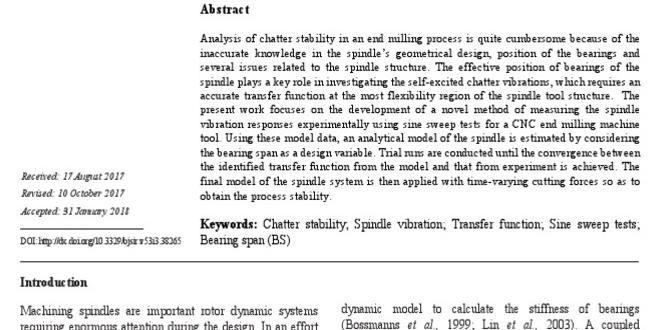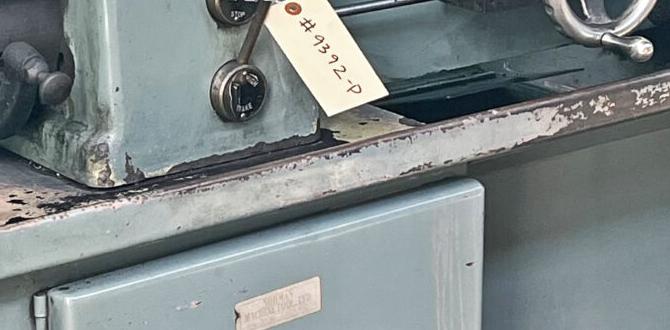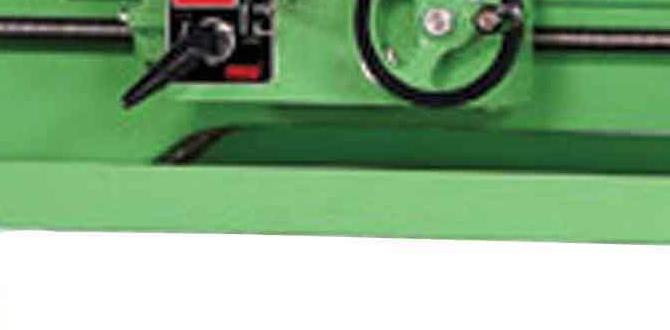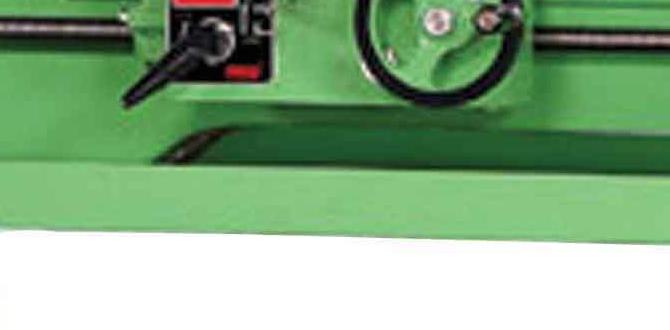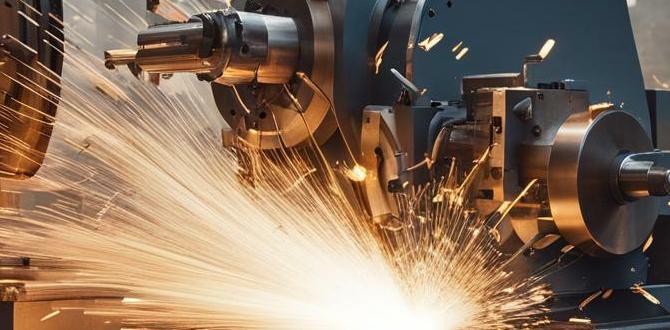Mastering wood lathe tool sharpening is easier than you think! This guide provides step-by-step video techniques to keep your tools razor-sharp for perfect woodturning results every time. Learn proven methods to confidence and precision.
Welcome to Lathe Hub! I’m Daniel Bates, and I believe that anyone can master the art of the lathe. Keeping your wood lathe tools sharp is one of the most critical skills you’ll develop. Dull tools don’t just make your work harder; they can be downright dangerous! They require more force, increasing the risk of kickback or a runaway workpiece. The good news is that with the right techniques and a little practice, sharpening your tools can become a straightforward, even satisfying, part of your woodworking process. Today, we’re diving into proven methods, perfect for beginners, that will have your tools slicing through wood like butter.
You’ll learn how to identify when your tools need attention and the exact steps to bring them back to peak performance. We’ll cover the essential tools you need for sharpening and some common pitfalls to avoid. By the end of this guide, you’ll have the confidence and knowledge to tackle any sharpening job, ensuring smoother cuts, better finishes, and a much safer experience at your wood lathe.
Why Sharp Tools Are Your Woodworking Best Friend
Think of your wood lathe tools like a sharp chef’s knife. A dull knife requires more pressure, can slip, and tears food instead of slicing cleanly. The same applies to your turning tools. Sharp tools bite into the wood predictably, allowing you to remove material with minimal effort and control. This results in cleaner cuts, less tear-out, a smoother surface finish, and significantly less strain on you. Ultimately, it means better-looking projects and a more enjoyable woodworking experience.
When your tools are sharp, they:’
- Cut with less force, reducing splintering and tear-out.
- Require less physical effort, preventing fatigue.
- Provide better control, leading to safer operation.
- Achieve a finer surface finish, reducing sanding time.
- Make the entire turning process more enjoyable and productive.
Identifying a Dull Wood Lathe Tool
Recognizing the signs of a dull tool is the first step to maintaining their performance. It’s not always as obvious as a completely blunt edge. Often, the deterioration is gradual. Pay attention to how your tools behave:
- Squealing or Screeching: If your gouge starts to make a high-pitched noise as it cuts, it’s struggling.
- Tear-out and Burning: Dull tools tend to rip wood fibers rather than shear them, leading to a ragged surface and sometimes even burn marks.
- Requires Excessive Force: You shouldn’t have to muscle your way through a cut. If you find yourself pushing too hard, the tool is likely dull.
- Doesn’t “Catch” the Wood: When sweeping a bevel or making a shearing cut, a sharp tool will glide smoothly. A dull tool will hesitate or skip.
- Crumbly Chips: Instead of nice, long shavings, you’re getting small chips or dust, indicating the tool is crushing the wood rather than cutting it.
A quick visual check can also help. Look at the cutting edge under good light. A sharp edge will appear as a fine, bright line. If you see a dull, rounded, or dark line, it’s time to sharpen.
Essential Sharpening Tools and Materials
You don’t need a vast array of specialized equipment to sharpen your wood lathe tools effectively. Here are the essentials:
- Sharpening Stones: This is your primary tool. A combination water stone (e.g., 1000/6000 grit) is excellent for beginners. A coarser grit (like 220 or 400) is useful for repairing minor damage or establishing a bevel.
- Honing Guide: This jig holds your chisel or gouge at a consistent angle, making it much easier to maintain the correct bevel when sharpening.
- Micro-mesh or Leather Strop: For that final polish after stones. A leather strop, often with a polishing compound, will give you a razor-sharp, burr-free edge.
- Shop Towels or Rags: For cleaning tools and stones.
- Water or Lubricant: Depending on the type of stone you use (water stones need water, oil stones need oil). Check the manufacturer’s recommendations.
- Safety Glasses: Always protect your eyes.
- Optional: Diamond Sharpening Plates: These are durable and can sharpen any steel but can be more expensive.
- Optional: Grinding Wheel: A slow-speed grinder (1750 RPM or less) with water cooling is ideal for more aggressive shaping or repairing damaged tools, but it requires more skill to avoid overheating the tool. We’ll focus on stone sharpening here as it’s more approachable.
The Absolute Basics: Understanding Bevel Angles
The ‘bevel’ is the angled surface that forms the cutting edge of your tool. Most woodturning tools have a primary bevel and often a secondary bevel (or micro-bevel) for added strength and longevity.
Understanding the correct angles is crucial for efficient cutting. Here’s a quick guide to common tool angles:
| Tool Type | Primary Bevel Angle | Typical Use |
|---|---|---|
| Spindle Gouge | 30-40 degrees | Shaping spindles, general-purpose cuts |
| Bowl Gouge | 30-55 degrees (depending on grind) | Hollowing bowls, shearing cuts |
| Scraper | 90 degrees (or slightly back-beveled) | Finishing end grain, smoothing |
| Skew Chisel | 15-25 degrees (for the dominant edge) | Shearing cuts, smoothing large surfaces |
Note: These are general guidelines. Specific grinds and tool designs can influence optimal angles. For beginners, aiming for consistency is more important than hitting exact degrees initially.
Maintaining a consistent angle during sharpening is key. This is where a good honing guide becomes invaluable.
Proven Technique 1: Sharpening a Spindle Gouge (The Workhorse)
The spindle gouge is likely the first tool you’ll use extensively. Keeping its fingernail-shaped edge sharp is essential for smooth turning. Here’s a breakdown of how to sharpen it using stones.
Step-by-Step Sharpening for a Spindle Gouge:
- Prepare Your Stone: If using a water stone, soak it in water until the bubbling stops (usually 5-10 minutes). Place it on a stable, non-slip surface.
- Set Up the Honing Guide: Adjust your honing guide to hold the gouge securely at the desired angle (around 30-40 degrees for a spindle gouge). The distance the gouge protrudes from the guide will determine the angle; practice this to find what works.
- Position the Gouge: Place the tip of the gouge in the honing guide so that the bevel rests flat on the sharpening stone.
- Sharpen One Side: Hold the tool and guide firmly. Move the gouge against the stone in a sweeping motion, mimicking the flute of the gouge. Use consistent pressure. Sharpen until you feel a small burr (a slightly rough edge) form along the opposite side of the cutting edge. Test this by gently running your fingertip away from the edge.
- Sharpen the Other Side: Flip the gouge over in the honing guide so the bevel on the other side is presented to the stone. Sweep the tool again until a burr forms along the first sharpened side.
- Refine the Tip: To ensure the point is sharp and the burr is removed, you might need to do a few light passes with the tip of the gouge directly on the stone, or sweep the stone across the very tip.
- Move to Finer Grits: Repeat steps 3-5 on a finer grit stone (e.g., 1000 grit). Use lighter pressure. The goal here is to refine the edge and remove the coarser scratches.
- Strop for the Final Edge: A leather strop loaded with honing compound will bring the edge to a mirror finish. Lightly drag the bevel across the strop, maintaining the same angle you used on the stones. Do this several times on each side.
Watch this spindle gouge sharpening video for a visual demonstration of these steps.
Proven Technique 2: Sharpening a Bowl Gouge (For Those Deeper Cuts)
Bowl gouges are designed for heavier cuts and often have a more pronounced “sweep” or flute. The sharpening process is similar to a spindle gouge, but the angles can vary, and you often focus on maintaining a specific grind shape (like a “standard” or “fluted” grind).
Step-by-Step Sharpening for a Bowl Gouge:
- Prepare and Set Up: Similar to the spindle gouge, prepare your stone(s) and setting up the honing guide. The angle for a bowl gouge can be slightly steeper, often between 35-55 degrees depending on the grind and intended use. A standard bowl gouge grind often has a slightly higher angle than a spindle gouge.
- Position the Gouge: Place the bowl gouge in the honing guide. You want to present the bevel to the stone. For a standard grind, you’ll typically sharpen from the outer wings towards the center point.
- Sharpen the Wings: Move the gouge against the stone in a sweeping motion that follows the curve of the gouge’s flute. Ensure you are sharpening the entire bevel surface of the wings. Sharpen one side until a burr forms along the opposite cutting edge.
- Sharpen the Other Side: Flip the gouge in the guide and repeat the sweeping motion on the other side, ensuring you sharpen both wings and eventually the point, until a burr forms on the first side.
- Sharpen the Tip (Point): For a standard grind, the tip is crucial. You might need to hold the gouge by hand (without the guide) and lightly rub the very tip on the stone at the correct angle to create a sharp point. Alternatively, some techniques involve a slight rotation of the gouge as you sweep to maintain the point.
- Progress to Finer Grits: Move to your finer grit stones and strop as described for the spindle gouge. The goal is a clean, sharp edge with no burr.
A common bowl gouge grind is the “fluted” or “Irish Set,” which can make shearing cuts easier. This involves creating a more hooked shape. Sharpening this grind can be done on grinder jigs (like the Oneway Wolverine system) or carefully by hand on stones.
This video on sharpening a bowl gouge offers a great visual walkthrough.
Proven Technique 3: Sharpening Scrapers (For that Glassy Finish)
Scrapers are often overlooked but are powerful tools for achieving incredibly smooth finishes, especially on end grain or when dealing with difficult woods. They don’t cut like gouges; they shear and create fine dust. Keeping their burr sharp is paramount.
Step-by-Step Sharpening for a Scraper:
- Prepare and Set Up: You’ll need a fine grit sharpening stone (e.g., 1000 grit or finer) and a burnisher. A burnisher is typically a hardened steel rod.
- Flatten the Scraper: Use your fine grit stone to ensure the face of the scraper where the burr will be formed is perfectly flat.
- Create the Scraper Burr: This is the key step for scrapers. Place the scraper flat on the stone. Hold a burnisher at approximately a 45-degree angle to the edge of the scraper. Drag the burnisher along the entire length of the edge, applying firm pressure. This action curls the very edge over, creating a tiny, sharp burr. You’ll need to do this along the entire scraping edge. A video like this on scraper sharpening is highly recommended for understanding the burnishing process.
- Repeat for Other Sides (if applicable): Some scrapers have multiple scraping edges. Burnish each one as needed.
- Final Polish: A very light pass on a strop can sometimes refine the burr and extend its life.
The burr created by burnishing is delicate and will wear down. You’ll need to re-burnish frequently when turning. This method is far quicker than grinding and ideal for on-the-fly adjustments.
Proven Technique 4: Sharpening a Skew Chisel (The Shearing Master)
The skew chisel is a versatile tool for smoothing, peeling, and creating decorative details, but it demands a sharp edge. Its specific angles can be tricky, but the principle remains the same.
Step-by-Step Sharpening for a Skew Chisel:
- Prepare and Set Up: Use your stones, and a honing guide if you can adapt it to the skew’s profile. Many turners find it easier to sharpen a skew freehand or with specialized jigs.
- Identify the Cutting Edge: A skew has two bevels and two cutting edges. You typically sharpen one edge at a time, often the one that will do the primary shearing work.
- Angle and Sweep: Hold the skew at the correct bevel angle (often a shallower angle, around 15-25 degrees for the primary shear edge). Place the bevel on the stone and sweep from side to side, similar to a gouge, but following the straight line or slight curve of the edge. Ensure you sharpen the entire edge. A burr should form on the opposite side.
- Sharpen Both Sides: Repeat the process for the opposite cutting edge, or if you’re sharpening one specific edge for a particular cut, focus only on that.
- Refine and Strop: Progress to finer grits and strop the edge to a keen finish. The goal is a clean, burr-free line.
The nuanced way a skew is used means its sharpening can be less about a perfect grind and more about maintaining a hair-popping edge. Check out this guide on skew chisel sharpening.
Sharpening vs. Honing: What’s the Difference?
It’s important to understand the distinction between sharpening and honing:
- Sharpening: This is the process of removing metal to create a new, sharp cutting edge. It involves grinding or abrasion (using stones or grinding wheels) and is done when the tool has become significantly dull, chipped, or damaged.
- Honing: This is the process of refining an already sharp edge and removing any microscopic burrs or irregularities. It’s done more frequently and uses finer abrasives like strops or very fine stones. Honing maintains the edge between sharpenings.
Regular honing will extend the time between full sharpenings, making your overall tool maintenance quicker and easier.
Video Resources: Seeing Is Believing
While reading about sharpening is helpful, watching it in action is invaluable. Here are some excellent resources:
- YouTube: Search for specific tool types (e.g., “wood lathe spindle gouge sharpening,” “bowl gouge sharpening jig”). Channels dedicated to woodworking often have excellent, in-depth videos. Look for established makers and educators.
- Tool Manufacturer Websites: Many tool manufacturers or sharpening system producers (like Oneway, Carter, Tormek) offer instructional videos or guides on their websites demonstrating how to use their products.
- Woodworking Forums and Communities: Users often share their preferred techniques and links to helpful videos.
A quick YouTube search for “wood lathe tool sharpening video” will yield a wealth of opportunities. Pay attention to how the presenter holds the tool, the motion used on the stone, and how they check for the burr.
Common Sharpening Mistakes and How to Avoid Them
Even with the best intentions, beginners can make mistakes. Here are a few common ones:
- Overheating the Tool: This is a major concern, especially when using grinders. Overheated steel loses its temper and will not hold an edge. Always use a slower speed grinder (1750 RPM or less) and keep the tool cool, frequently dipping

